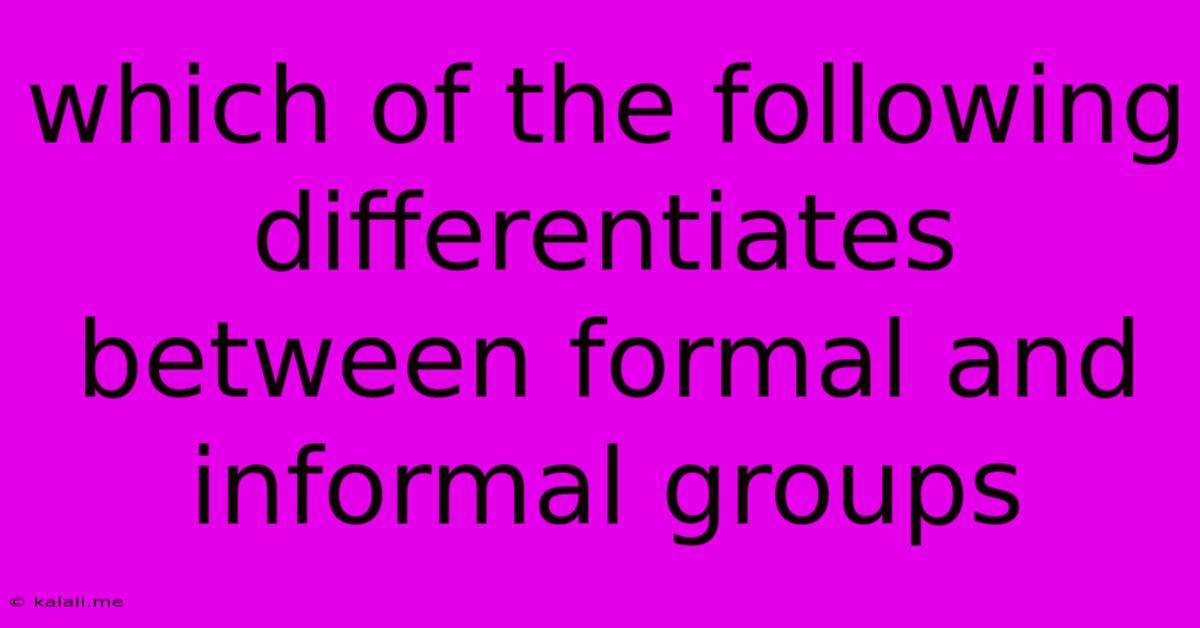Which Of The Following Differentiates Between Formal And Informal Groups
Kalali
Jun 15, 2025 · 3 min read

Table of Contents
What Differentiates Formal and Informal Groups?
This article explores the key distinctions between formal and informal groups, examining their structures, purposes, and impact on individuals and organizations. Understanding these differences is crucial for effective teamwork, leadership, and organizational management. We'll delve into the defining characteristics, providing a clear comparison to help you readily identify each group type.
What is a Group? Before we dissect the differences, let's define what constitutes a group. A group is a collection of individuals who interact with each other, share common goals or interests, and perceive themselves as a unit. However, the nature of these interactions, goals, and perceptions vary significantly depending on whether the group is formal or informal.
Defining Characteristics: Formal vs. Informal Groups
The most significant differences between formal and informal groups lie in their structure, formation, purpose, and communication patterns. Let's break down these key distinctions:
1. Structure and Formation:
- Formal Groups: These groups are deliberately created by an organization to achieve specific goals. They have a defined structure, with roles, responsibilities, and reporting relationships clearly established. Think of project teams, departments, or committees. Membership is usually assigned, often based on skills or expertise.
- Informal Groups: These groups emerge naturally from social interactions within an organization. They are not formally structured, and membership is voluntary. Friendships formed within the workplace, interest-based groups, or groups that spontaneously form to address a common concern are examples.
2. Purpose and Goals:
- Formal Groups: Their primary purpose is to accomplish organizational objectives. They are task-oriented, with specific targets and deadlines. Performance is often measured and evaluated against pre-defined criteria.
- Informal Groups: Their purposes are more varied and often centered around social interaction, emotional support, or shared interests. While they may indirectly contribute to organizational goals, their primary focus is not task-completion.
3. Communication Patterns:
- Formal Groups: Communication follows established channels, often dictated by the organizational hierarchy. Formal meetings, reports, and emails are common modes of communication.
- Informal Groups: Communication is less structured and often more casual. It may occur through informal conversations, social media, or even shared lunches. This allows for quicker information dissemination but can also lead to the spread of rumors or misinformation.
4. Influence and Power:
- Formal Groups: These groups exert influence based on their organizational authority and the power vested in their roles. Their decisions often have a direct impact on the organization's performance and strategy.
- Informal Groups: Their influence is less direct but can be substantial. They can shape attitudes, opinions, and behavior within the organization. They can act as powerful opinion leaders, influencing morale, productivity, and even decision-making.
5. Leadership and Roles:
- Formal Groups: Formal leadership is usually assigned, often based on position within the organizational hierarchy. Roles and responsibilities are explicitly defined.
- Informal Groups: Leadership emerges naturally, based on personality, skills, or social influence. Roles are less clearly defined and may fluctuate depending on the situation.
The Interplay Between Formal and Informal Groups
While seemingly distinct, formal and informal groups often interact and influence each other. Informal groups can support the goals of formal groups by fostering teamwork and communication. Conversely, the dynamics of informal groups can sometimes impede the effectiveness of formal groups if conflicts or disagreements arise. Understanding this interplay is crucial for effective management.
Conclusion
Formal and informal groups represent distinct yet intertwined facets of organizational life. By recognizing the characteristics that differentiate them, leaders and managers can better understand group dynamics, harness the strengths of each type, and mitigate potential challenges. This leads to a more productive, engaged, and successful work environment.
Latest Posts
Latest Posts
-
What Is The Lcm Of 5 6 7
Jun 15, 2025
-
What Body Of Water Separates Africa From Europe
Jun 15, 2025
-
The Resistance And The Magnitude Of The Current Depend
Jun 15, 2025
-
The Graphic Representation Of Data In A Worksheet
Jun 15, 2025
-
Multiple Choice Questions On Endocrine System
Jun 15, 2025
Related Post
Thank you for visiting our website which covers about Which Of The Following Differentiates Between Formal And Informal Groups . We hope the information provided has been useful to you. Feel free to contact us if you have any questions or need further assistance. See you next time and don't miss to bookmark.